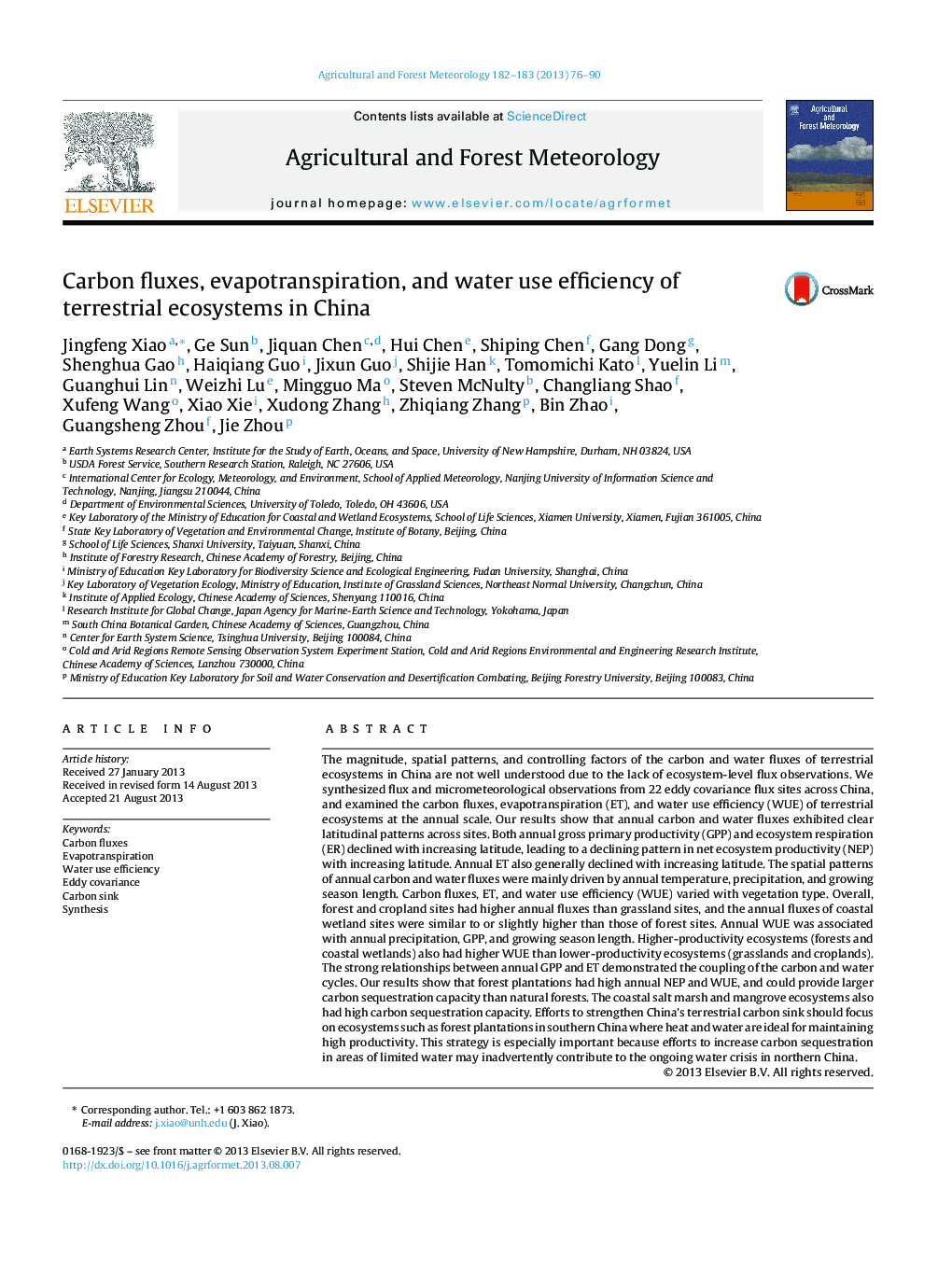| کد مقاله | کد نشریه | سال انتشار | مقاله انگلیسی | نسخه تمام متن |
|---|---|---|---|---|
| 6537726 | 158343 | 2013 | 15 صفحه PDF | دانلود رایگان |
عنوان انگلیسی مقاله ISI
Carbon fluxes, evapotranspiration, and water use efficiency of terrestrial ecosystems in China
ترجمه فارسی عنوان
فسفر کربن، تبخیر تعرق و بهره برداری از آب اکوسیستم های زمینی در چین
دانلود مقاله + سفارش ترجمه
دانلود مقاله ISI انگلیسی
رایگان برای ایرانیان
کلمات کلیدی
موضوعات مرتبط
مهندسی و علوم پایه
علوم زمین و سیارات
علم هواشناسی
چکیده انگلیسی
The magnitude, spatial patterns, and controlling factors of the carbon and water fluxes of terrestrial ecosystems in China are not well understood due to the lack of ecosystem-level flux observations. We synthesized flux and micrometeorological observations from 22 eddy covariance flux sites across China, and examined the carbon fluxes, evapotranspiration (ET), and water use efficiency (WUE) of terrestrial ecosystems at the annual scale. Our results show that annual carbon and water fluxes exhibited clear latitudinal patterns across sites. Both annual gross primary productivity (GPP) and ecosystem respiration (ER) declined with increasing latitude, leading to a declining pattern in net ecosystem productivity (NEP) with increasing latitude. Annual ET also generally declined with increasing latitude. The spatial patterns of annual carbon and water fluxes were mainly driven by annual temperature, precipitation, and growing season length. Carbon fluxes, ET, and water use efficiency (WUE) varied with vegetation type. Overall, forest and cropland sites had higher annual fluxes than grassland sites, and the annual fluxes of coastal wetland sites were similar to or slightly higher than those of forest sites. Annual WUE was associated with annual precipitation, GPP, and growing season length. Higher-productivity ecosystems (forests and coastal wetlands) also had higher WUE than lower-productivity ecosystems (grasslands and croplands). The strong relationships between annual GPP and ET demonstrated the coupling of the carbon and water cycles. Our results show that forest plantations had high annual NEP and WUE, and could provide larger carbon sequestration capacity than natural forests. The coastal salt marsh and mangrove ecosystems also had high carbon sequestration capacity. Efforts to strengthen China's terrestrial carbon sink should focus on ecosystems such as forest plantations in southern China where heat and water are ideal for maintaining high productivity. This strategy is especially important because efforts to increase carbon sequestration in areas of limited water may inadvertently contribute to the ongoing water crisis in northern China.
ناشر
Database: Elsevier - ScienceDirect (ساینس دایرکت)
Journal: Agricultural and Forest Meteorology - Volumes 182â183, 15 December 2013, Pages 76-90
Journal: Agricultural and Forest Meteorology - Volumes 182â183, 15 December 2013, Pages 76-90
نویسندگان
Jingfeng Xiao, Ge Sun, Jiquan Chen, Hui Chen, Shiping Chen, Gang Dong, Shenghua Gao, Haiqiang Guo, Jixun Guo, Shijie Han, Tomomichi Kato, Yuelin Li, Guanghui Lin, Weizhi Lu, Mingguo Ma, Steven McNulty, Changliang Shao, Xufeng Wang, Jie Zhou,
